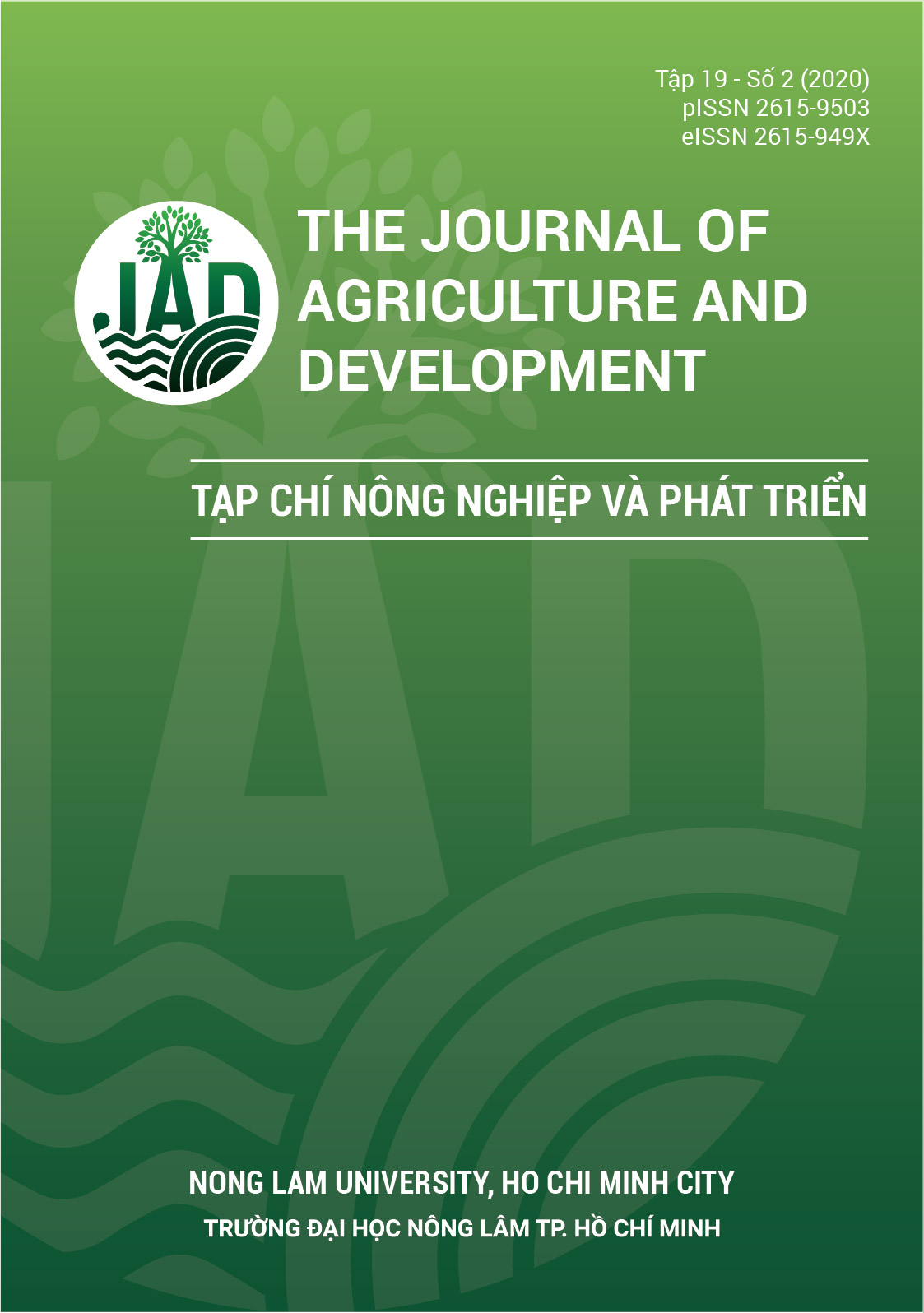Replacement of rotifer with Artemianauplii in clownfish larvae rearing (Amphiprion percula Lacepede, 1802)
Main Article Content
Abstract
This study was conducted to minimize the period of using rotifer in rearing percula clownfish larvae from newly hatched to 30 days. Artemia nauplii was used to replace rotifer when the larvae reached 5, 7, 9, 11 and 13 days after hatching (DAH). The results showed that larvae fed with Artemia nauplii starting from 7 DAH achieved the highest specific growth rate in standard length (4,02%/day). The later the starting point of weaning was, the lower the larval specific growth rate was. The lowest specific growth rate was at 13 DAH (3.21%/day;P < 0.05). However, there were no significant differences in the specific growth rate among the weaning times at 5, 9 and 11 DAH (P > 0.05). Similarly, the starting points of weaning times had no significant effects on larval survival rate, ranging from 39,6 - 48,2% (P > 0.05). The results of this study helped reduce the period of using rotifer in rearing the clownfish larvae which contributes to the improvement of larval performance in artificialre production of this species.
Article Details
References
Allen, G. R. (1972). The anemonefishes: Their classification and biology (2nd ed.). New Jersey, America: T.F.H Publications.
Cortney, L. O, Eric, J. C., & Rhodes, A. (2016). Choosing an appropriate live feed for larviculture of marine fish. Florida, USA: UF IFAS Extension, University of Florida.
Cunha, I., & Planas, M. (1999). Optimal prey size for early turbot larvae (Scophthalamus maximus) based on mouth and ingested prey size. Aquaculture 175(1-2), 103-110. https://doi.org/10.1016/S0044-8486(99)00040-X
Dabrowski, K., & Bardega, R. (1984). Mouth size and predicted food size preferences of larvae of three cyprinid fish species. Aquaculture 40(1), 41-45. https://doi.org/10.1016/0044-8486(84)90214-X
Fernández-Diaz, C., Pascual, E., & Yúfera, M. (1994). Feeding behaviour and prey size selection of gilthead seabream, Sparus aurata, larvae fed on inert and live food. Marine Biology 118, 323-328. https://doi.org/10.1007/BF00349800
Gordon, A. K. (1999). The effect of diet and age-at weaning on growth and survival of clownfish Amphiprion percula Pisces: Pomacentridae (Unpublished master’s thesis). Rhodes University, Grahamstown, South Africa.
Green, B. S., & McCormick, M. I. (1999). Influence of larval feeding history on the body condition of Amphiprion melanopus. Journal of Fish Biology 55(6), 1273-1289. https://doi.org/10.1111/j.1095-8649.1999.tb02075.x
Hoff, F. H. (1996). Conditioning, spawning and rearing of fish with emphasis on marine clownfish. Florida, USA: Aquaculture Consultants Inc.
Houde, E. D., & Schekter, R. C. (1980). Feeding by marine fish larvae: developmental and functional responses. Environmental Biology of Fishes 5, 315-334. https://doi.org/10.1007/BF00005186
Hunter, J. P. (1981). Feeding ecology and predation of marine fish larvae. In Lasker, R. (Ed.). Marine fish larvae: Morphology, ecology, and relation to fisheries (33-77). Washington, USA: University of Washington Press.
Lavens, P., & Sorgeloos, P. (1999). Manual on the production and use of live food for aquaculture. Rome, Italy: FAO.
Léger, P., Bengtson D. A., Simpson K. L., & Sorgeloos P. (1986). The use and nutritional value of Artemia as a food source. Oceanography and Marine Biology And Annual Review 24, 521-623.
Lubzens, E., Tandler, A., & Minkoff, G. (1989). Rotifers as food in aquaculture. Hydrobiologia 186(1), 387-400. https://doi.org/10.1007/BF00048937
Moteki, M., Ishikawa, T., Teraoka, N., & Fushimi, H. (2001). Transition from endogenous to exogenous nutritional sources in larval sea bream. Pagrus major. Suisanzoshoku
Onal, U., Langdon, C., & Celik, I. (2008). Ontogeny of the digestive tract of larval percula clownfish, Amphiprion percula (Lacepede, 1802): a histological perspective. Aquaculture Research 39(10), 1077-1086. https://doi.org/10.1111/j.1365-2109.2008.01968.x
Shirota, A. (1970). Studies on the mouth size of fish larvae. Bulletin of the Japanese Society for the Science of Fish 36(4), 353-368. https://doi.org/10.2331/suisan.36.353
Stottrup, J. G., & McEvoy, L. A. (2003). Live feeds in marine aquaculture. Oxford, United Kingdom: Blackwell Scientific Publications Ltd. https://doi.org/10.1002/9780470995143
Tacon, A. G. J. (1988). The nutrition and feeding of farmed fish and shrimp - A training manual. 3. Feeding methods. FAO Field Document, Project GP/RLA/075/ITA Field Document No. 7, Brasilia, Brazil.
Wilkerson, J. D. (2001). Clownfishes: A guide to their captive care, breeding and natural history. New Jersey, USA: T. F. H Publications Inc.








